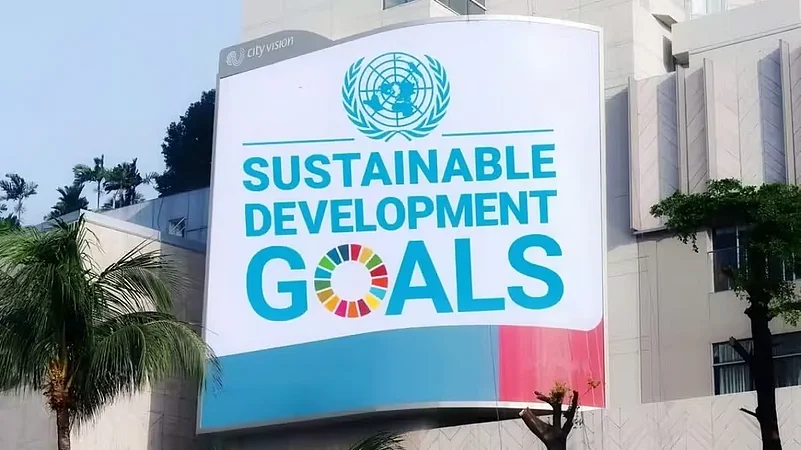At first glance, it looks like a leap. For the first time, India has broken into the top 100 of the United Nations Sustainable Development Goals (SDG) Index—ranking 99th out of 167 countries in the 2025 report released this week. The numbers point to movement: a composite score of 67 out of 100, buoyed by advances in health, clean energy, sanitation, and housing.
That might seem impressive, but India’s flight has, in fact, been bumpy at best— steep climbs powered by infrastructure, offset by sharp dips in nutrition, gender equality, and ecological justice. The real message of the SDG report is not in the rankings: It is in the rift: between promise and delivery, intent and outcome.
This is not the first time India has made visible strides on the development front. What’s different now is the narrowing timeline. With just five years to go before the 2030 deadline to achieve the United Nations Sustainable Development Goals, the gains—and gaps—are under sharper scrutiny.
The country’s climb up the SDG ladder has been propelled by large-scale public programmes aligned with high-impact development goals. Rural water access has expanded dramatically under the Jal Jeevan Mission, which now covers over 75% of rural households with piped supply. Government data pegs access to improved drinking water at 99.29%, a number that, while impressive, rests heavily on infrastructure counts rather than quality or consistency of supply.
The sanitation story follows a similar arc. Swachh Bharat’s aggressive toilet-building push has helped the country edge closer to universal sanitation coverage; but behavioural adoption and waste management remain unresolved.
Clean energy, however, is where India’s gains are both indubitable and strategic. With 220.10 GW of installed renewable capacity—half of it solar—India now ranks among the world’s top five renewable energy producers. An additional 169.40 GW is under implementation, giving SDG 7 (Affordable and Clean Energy) one of the country’s most robust scorecards. Supplementing this is the Ujjwala Yojana, which extended LPG connections to low-income households and reduced dependence on biomass.
In health, schemes like Ayushman Bharat and digital outreach platforms have expanded coverage, particularly in underserved geographies. Housing under PM Awas Yojana has also delivered volume—nearly 3 crore rural homes sanctioned. Yet as with water and sanitation, volume is not the same as quality.
These initiatives, taken together, project a narrative of deliberate, state-led intervention across critical social sectors. But the data also reveals another truth: India’s SDG report card is a case study in asymmetry.
The sharpest rupture is gender. SDG 5 (Gender Equality) continues to be India's weakest link, with a national score of just 49 out of 100. The pay gap between male and female regular-wage earners remains at 25%, and the sex ratio at birth is still skewed—929 girls for every 1,000 boys, far below the national target of 950. These are not just statistical anomalies—they are systemic failures that speak to deeper cultural and structural deficits.
Nutrition is another area where gains have not kept pace with ambition. Despite the country’s food self-sufficiency, SDG 2 (Zero Hunger) reveals grim undercurrents. One in three children under five is underweight. Over 35% are stunted. And more than half of pregnant women aged 15–49 suffer from anaemia, according to NFHS-5 data. These are figures that no economic growth curve can offset.
Such deficits cast long shadows—not just for human capital, but for long-term productivity and economic competitiveness. And they raise an uncomfortable question: can development truly be called inclusive if it fails its most vulnerable?
India’s entry into the Top 100 of the SDG Index is both a signal and a stress test. A signal that targeted public spending and large-scale delivery can move the needle on global metrics. A stress test, because delivery alone is not enough. The foundation is laid—but the architecture is incomplete.
What India needs now is not more schemes, but deeper systems. Not more infrastructure, but more accountability. The SDG gap is no longer about ambition. It is about alignment—between economic growth and social justice, between headline numbers and lived realities.
As the world barrels toward the 2030 deadline, the question is no longer whether India is progressing. It is whether that progress can be sustained, scaled, and made equitable. In that answer lies the future of the world’s largest democracy—and its development model.



























